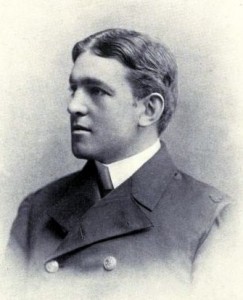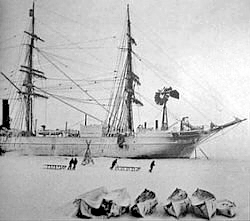“Then came a fateful day—Wednesday, October 27. The position was lat. 69° 5´ S., long. 51° 30´ W. The temperature was —8.5° Fahr., a gentle southerly breeze was blowing and the sun shone in a clear sky.
“After long months of ceaseless anxiety and strain, after times when hope beat high and times when the outlook was black indeed, the end of the Endurance has come. But though we have been compelled to abandon the ship, which is crushed beyond all hope of ever being righted, we are alive and well, and we have stores and equipment for the task that lies before us. The task is to reach land with all the members of the Expedition. It is hard to write what I feel. To a sailor his ship is more than a floating home, and in the Endurance I had centred ambitions, hopes, and desires. Now, straining and groaning, her timbers cracking and her wounds gaping, she is slowly giving up her sentient life at the very outset of her career. She is crushed and abandoned after drifting more than 570 miles in a north-westerly direction during the 281 days since she became locked in the ice. The distance from the point where she became beset to the place where she now rests mortally hurt in the grip of the floes is 573 miles, but the total drift through all observed positions has been 1186 miles, and probably we actually covered more than 1500 miles. We are now 346 miles from Paulet Island, the nearest point where there is any possibility of finding food and shelter. A small hut built there by the Swedish expedition in 1902 is filled with stores left by the Argentine relief ship. I know all about those stores, for I purchased them in London on behalf of the Argentine Government when they asked me to equip the relief expedition. The distance to the nearest barrier west of us is about 180 miles, but a party going there would still be about 360 miles from Paulet Island and there would be no means of sustaining life on the barrier. We could not take from here food enough for the whole journey; the weight would be too great.
“This morning, our last on the ship, the weather was clear, with a gentle south-south-easterly to south-south-westerly breeze. From the crow’s-nest there was no sign of land of any sort. The pressure was increasing steadily, and the passing hours brought no relief or respite for the ship. The attack of the ice reached its climax at 4 p.m. The ship was hove stern up by the pressure, and the driving floe, moving laterally across the stern, split the rudder and tore out the rudder-post and stern-post. Then, while we watched, the ice loosened and the Endurance sank a little. The decks were breaking upwards and the water was pouring in below. Again the pressure began, and at 5 p.m. I ordered all hands on to the ice. The twisting, grinding floes were working their will at last on the ship. It was a sickening sensation to feel the decks breaking up under one’s feet, the great beams bending and then snapping with a noise like heavy gunfire. The water was overmastering the pumps, and to avoid an explosion when it reached the boilers I had to give orders for the fires to be drawn and the steam let down. The plans for abandoning the ship in case of emergency had been made well in advance, and men and dogs descended to the floe and made their way to the comparative safety of an unbroken portion of the floe without a hitch. Just before leaving, I looked down the engine-room skylight as I stood on the quivering deck, and saw the engines dropping sideways as the stays and bed-plates gave way. I cannot describe the impression of relentless destruction that was forced upon me as I looked down and around. The floes, with the force of millions of tons of moving ice behind them, were simply annihilating the ship.”
“South” By Sir Ernest Shackleton is his own account of the journey to the South Pole. This particular excerpt talks about the day him and his crew knew their ship, The Endurance, couldn’t be salvaged and they would have to continue their journey on what can only be called a life boat.



